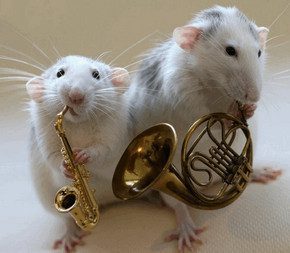
Animals and music: the influence of music on animals, animals with an ear for music
 We cannot establish for certain how other creatures hear music, but we can, through experiments, determine the effect of different types of music on animals. Animals can hear very high-frequency sounds and therefore are often trained with high-frequency whistles.
We cannot establish for certain how other creatures hear music, but we can, through experiments, determine the effect of different types of music on animals. Animals can hear very high-frequency sounds and therefore are often trained with high-frequency whistles.
The first person to conduct research about music and animals can be called Nikolai Nepomniachtchi. According to the research of this scientist, it was precisely established that animals grasp the rhythm well, for example, circus horses unerringly fall in time when the orchestra plays. Dogs also grasp the rhythm well (in the circus they dance, and domestic dogs can sometimes howl to their favorite melody).
Heavy music for birds and elephants
In Europe, an experiment was conducted at a poultry farm. They turned on heavy music for the chicken, and the bird began to spin around in place, then fell on its side and twitched in a convulsion. But this experiment raises the question: what kind of heavy music was it and how loud? After all, if the music is loud, it’s easy to drive anyone crazy, even an elephant. Speaking of elephants, in Africa, when these animals eat fermented fruits and begin to riot, local residents drive them away with rock music played through an amplifier.
Scientists also conducted an experiment on carp: some fish were placed in vessels closed from light, others in light-colored ones. In the first case, the carp’s growth slowed down, but when they were periodically played classical music, their growth became normal. It has also been found that destructive music has a negative effect on animals, which is quite obvious.
Animals with an ear for music
Scientists have conducted a series of experiments with gray parrots and found that these birds love something rhythmic, like reggae, and, surprisingly, calm down to the dramatic toccatas of Bach. What is noteworthy is that parrots have individuality: different birds (jacos) had different musical tastes: some listened to reggae, others loved classical compositions. It was also accidentally discovered that parrots do not like electronic music.
It was found that rats love Mozart (during experiments they were played recordings of Mozart’s operas), but few of them still prefer modern music to classical music.
Famous for his Enigma Variations, Sir Edward William Edgar became friends with the dog Dan, whose owner was a London organist. At choir rehearsals, the dog was noticed to growl at out-of-tune choristers, which earned him the respect of Sir Edward, who even dedicated one of his enigma variations to his four-legged friend.
Elephants have a musical memory and hearing, capable of remembering three-note melodies, and prefer the violin and bass sounds of low brass instruments rather than the shrill flute. Japanese scientists have found that even goldfish (unlike some people) respond to classical music and are able to make differences in compositions.
Animals in musical projects
Let’s look at the animals that have participated in various unusual musical projects.
As was noted above, dogs tend to howl to drawn-out compositions and voices, but they do not try to adapt to the tone, but rather try to keep their voice so that it drowns out the neighboring ones; this animal tradition originates from wolves. But, despite their musical characteristics, dogs sometimes participate in serious musical projects. For example, at Carnegie Hall, three dogs and twenty vocalists performed Kirk Nurock’s “Howl”; three years later, this composer, inspired by the result, will write a sonata for piano and dog.
There are other musical groups in which animals participate. So there is a “heavy” group Insect Grinder, where a cricket plays the role of vocalist; and in the band Hatebeak the vocalist is a parrot; In the Caninus team, two pit bulls sing.





